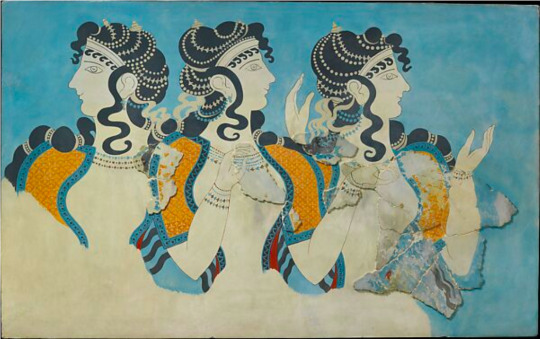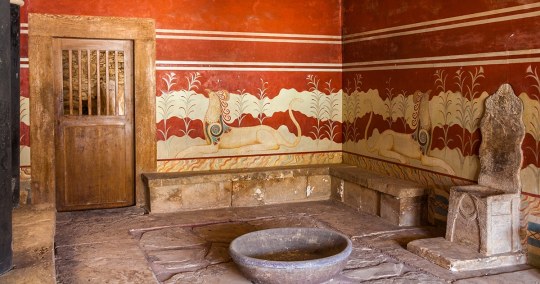#Emile Gillieron
Explore tagged Tumblr posts
Text



Émile Gilliéron (CH, 1850 - 1924)
Ladies in Blue fresco, Reproduction
The Prince of the Lilies, or the Lily Prince or Priest-King Fresco
The Knossos throne room (supposedly Minos')
This group of three women was originally restored by E. Gillieron (father) on the basis of other fragments of frescos. The facial outline of the "Cup-bearer" fresco supplied the model for the faces of the "Ladies in Blue". Excavated before 1914, Knossos.
The Prince of the Lily was assembled using various frescoes (Evans demanded results to impress and keep fund-raising)
Gilliérons (father & son) relocated to Athens, in 1877, where they produced archaeological illustrations for Greek and foreign excavators, designed commemorative postage stamps for the inaugural Olympic Games (1896 and 1906), and served as an art tutor for the royal family of George I.
Gilliéron worked for Heinrich Schliemann and gained a reputation as the best archaeological illustrator working in Greece at the time.
He became the chief restorer for Arthur Evans at the Knossos Palace. For over three decades, Gilliéron worked with his son, and successor, also named Émile, creating reproductions of frescoes and other artifacts.
Greece, before and after its liberation struggle, was a playground for archeologists/treasure hunters. Following Evans' discoveries, a "Cretan fever" spread over the Western world, thus creating a huge market for official copies, smuggled originals and forgeries. Gilliérons' prices skyrocketed.
An Odyssey History Documentaries 2022 production with the misleading clickbait title "Was Europe's First Advanced Civilization Faked? | The Secret of the Phaistos Code" is exposing the early ambiguous archeological approach, historical background and Gilliéron's talent to recreate free of accuracy illustrations and restorations, i.a.
https://www.metmuseum.org/art/collection/search/258137
https://en.wikipedia.org/wiki/%C3%89mile_Gilli%C3%A9ron
https://en.wikipedia.org/wiki/Prince_of_the_Lilies
https://mymodernmet.com/minoan-palace-of-knossos-crete/
https://www.youtube.com/watch?v=Phohy3fEq7U
22 notes
·
View notes
Text
#ancient colours#ancient#Greek#statue#art#Acropolis Museum#ancient Greece#article#Emile Gillieron#archaeology
43 notes
·
View notes
Photo

Reproduction of the Shield Frieze fresco ca. 1325-1250 B.C.
Emile Gilliéron
35 notes
·
View notes
Photo


Nome dell’opera: il principe dei gigli
Attribuzione: sconosciuta
Periodo: XVIII-XV secolo a.C.
Tecnica e materiali: affresco murale
Luogo di conservazione: Museo Nazionale Archeologico di Heraklion
Luogo di ritrovamento: Cnosso
* Sir.Arthur Evans ritrovò l’affresco a Cnosso e incaricò Emile Gillieron della sua integrazione (immagine a destra), che vide la comparsa di elementi di cui non vi era traccia (da qui il nome).
1 note
·
View note
Photo

Reproduction of an ancient Mycenaean sword circ 1600-1000 BC, crafted by Emile Gillieron.
from the Harvard Art Museums
844 notes
·
View notes
Text


Nome dell’opera: il principe dei gigli
Attribuzione: sconosciuta
Periodo: XVIII-XV secolo a.C.
Tecnica e materiali: affresco murale
Luogo di conservazione: Museo Nazionale Archeologico di Heraklion
Luogo di ritrovamento: Cnosso
* Sir.Arthur Evans ritrovò l’affresco a Cnosso e incaricò Emile Gillieron della sua integrazione (immagine a destra), che vide la comparsa di elementi di cui non vi era traccia (da qui il nome).
0 notes
Text


NOME: Principe dei Gigli
AUTORE: Ignoto
DATA: II millennio a.C
TECNICA: Affresco
RITROVAMENTO: Trovato nel palazzo di Cnosso da Evans il quale ne affidò la restaurazione ad Emile Gillieron che aggiunse i capelli ed i gigli
UBICAZIONE: Museo Archeologico Nazionale di Heraklion, Grecia 🇬🇷
0 notes
Photo

Las jóvenes de azul Fresco restaurado Civilización minoica (ca. 1500 a.C. - Minoico tardío) Museo Arqueológico de Heraclión (Isla de Creta) Fresco restaurado por Emile Gillieron a partir de restos del palacio de Cnosos hallados a principios del siglo XX por Sir Arthur Evans.
Imagen: https://liabxl.wordpress.com/2016/05/09/crete-8-the-archaeological-museum-heraklion/
0 notes
Link
0 notes
Photo

Reproduction of a bronze Mycenaean dagger circa 1600-1000 BC, crafted by Emile Gillieron and son.
from the Haravard Art Museums
261 notes
·
View notes